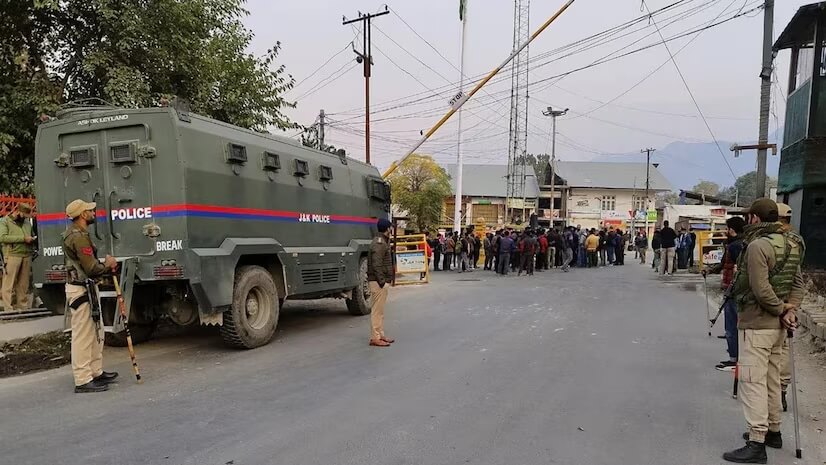By Altaf Hussain Wani
The Indian government, under Prime Minister Narendra Modi and Home Minister Amit Shah, has persistently propagated a narrative of “normalcy” and “integration” in Jammu and Kashmir since the revocation of its special status in August 2019.

Officials claim that Kashmiris are “leaving the path of violence” and embracing India’s constitutional framework with “pride.”
However, the ground reality, as evidenced by recent events, paints a starkly different picture—one of intensified militarization, systemic repression, and the ruthless silencing of dissent. The chasm between New Delhi’s rhetoric and the lived experiences of Kashmiris exposes a troubling contradiction that demands urgent global attention.
Militarization Masquerading as Security
The killing of Junior Commissioned Officer (JCO) Kuldeep Chand in an attack in the Akhnoor sector and the subsequent military crackdowns exemplify the volatile environment in the region. Following the incident, Indian forces launched extensive cordon-and-search operations, deploying reinforcements and restricting civilian movement. Such operations, framed as “retaliatory measures,” have become routine, transforming entire neighborhoods into open-air prisons. The Srinagar-Jammu Highway, a critical lifeline for Kashmiris, now resembles a militarized zone, with checkpoints, sniffer dogs, and surveillance tools scrutinizing every vehicle and individual.
While Indian authorities justify these measures as necessary for “security,” locals perceive them as tools of collective punishment designed to instill fear. The heavy troop presence and invasive surveillance contradict claims of stability. If Kashmiris were truly “integrating” willingly, why does the state rely on such oppressive tactics? The answer lies in New Delhi’s refusal to acknowledge the political roots of the conflict, opting instead to suppress dissent through brute force.
Human Rights Violations
The recent killing of three Kashmiri youth in Kishtwar district during a prolonged military operation underscores the human cost of India’s counterinsurgency strategy. What began as a search operation in Chattru forest culminated in extrajudicial killings, a pattern consistent with decades of state violence. Indian forces routinely label victims as “terrorists” to legitimize their actions, but eyewitness accounts and local narratives often reveal a darker truth—the targeting of civilians and activists opposed to occupation.
These operations are not isolated incidents. Data from rights groups highlight a surge in civilian casualties, arbitrary detentions, and torture since 1989. The Armed Forces Special Powers Act (AFSPA), which grants troops legal immunity, has further emboldened human rights abuses, among the international community’s silence.
Silencing Dissent: The War on Political Expression
Parallel to military operations, India has waged a systematic campaign to dismantle Kashmiri political resistance. The Hurriyat Conference, a coalition of pro-freedom groups, has borne the brunt of this crackdown. Its leaders face house arrests, arbitrary detentions, and coerced “affidavit submissions” renouncing their political stances. Such tactics, reminiscent of colonial-era subjugation, aim to erase dissent from public memory and create an illusion of consent.
The criminalization of protest extends beyond political outfits. Students, journalists, and civil society actors risk harassment, imprisonment, or worse for criticizing state policies. The arrest of human rights defender Kharrum parvez, journalist Irfan Mehraj , Sajjad Gul, Asif Sultan for “anti-national” reporting, detention of Ashan Untoo, exemplifies this trend. By conflating dissent with terrorism, India seeks to delegitimize the Kashmiri struggle for self-determination—a right enshrined in UN resolutions.
Development or Propaganda? The Facade of Progress
Amid this repression, the Indian government has aggressively marketed infrastructure projects like the Udhampur-Srinagar-Baramulla Rail Link (USBRL) as symbols of “development.” Modi’s planned inauguration of the project in Reasi has been accompanied by draconian security measures, including. Such projects, while economically significant, cannot mask the grim realities of occupation. Infrastructure built under the shadow of militarization serves as a propaganda tool, designed to project normalcy to the outside world while ignoring the alienation of Kashmiris.
Moreover, these initiatives often prioritize strategic military interests over local welfare.Highways and tunnels facilitate faster troop mobilization, further entrenching India’s control. For Kashmiris, “development” without political rights rings hollow—a sentiment echoed in protests against land grabs and resource exploitation.
Conclusion: The Myth of Voluntary Integration
Home Minister Amit Shah’s assertion that Kashmiris are “proudly” joining India’s constitutional framework is not just misleading—it is an affront to their decades-long struggle for dignity. The claim collapses under scrutiny when confronted with the reality of mass discontent: daily raids, enforced disappearances, and the criminalization of identity.
True normalcy cannot be achieved through bayonets and bureaucratic decrees. It requires addressing the political aspirations of Kashmiris, initiating dialogue with stakeholders, and respecting international law. Until then, India’s narrative of “peace” will remain a dangerous illusion, perpetuating cycles of violence and resentment. The world must look beyond state-sponsored propaganda and heed the voices of Kashmiris—voices that continue to demand freedom, justice, and the right to determine their own future.
The road to resolution begins with acknowledging the truth: peace in Kashmir is impossible without justice.
Author: Altaf Hussain Wani – Chairman at Kashmir Institute of International Relations (KIIR), Pakistan.
(The opinions expressed in this article are solely those of the author and do not necessarily reflect the views of World Geostrategic Insights).







